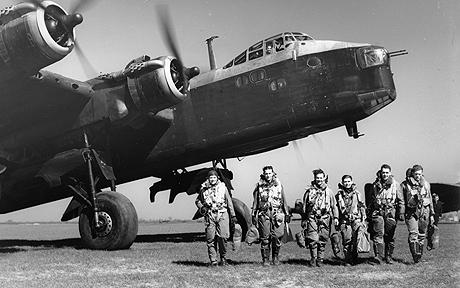The 218 Sqdn left from Downham Market at 1943-08-17 at 20:19. Loc or duty Torino
He flew with a Short Stirling (type III, serial EH884, code HA-X).
Campaign report of the USAAF:
(Eighth Air Force):: VIII Bomber Command Mission 84: On the first anniversary of US heavy bomber operations from the UK, a two-pronged attack into Germany is launched, marking the deepest penetra- tion of German territory to date. The critical targets are the Messer- schmitt complex at Regensburg, and the anti-friction-bearing factories at Schweinfurt.
1. 230 B-17's are dispatched to Schweinfurt; 188 hit the target at 1459- 1511 hours; they claim 148-18-63 Luftwaffe aircraft; 36 B-17's are lost, 3 are damaged beyond repair and 118 damaged; casualties are 3 KIA, 12 WIA and 352 MIA; there are 80 high explosive hits on the 2 main bearing plants. 2. 146 B-17's are dispatched to Regensburg; 127 hit the target at 1148- 1207 hours; they claim 140-19-36 Luftwaffe aircraft; 24 B-17's are lost, 1 is damaged beyond repair and 50 are damaged; casualties are 4 KIA, 9 WIA and 200 MIA; every important building in the complex is damaged; the surviving aircraft continue on to bases in North Africa. 60 B-17's are lost in the fierce air battle that extends to the targets and continues after the bombing. VIII Air Support Command Missions 23 and 24: Two airfields in France are targetted. 1.
36 B-26's are dispatched to Bryas Sud Airfield; 29 hit the target at 1051 hours; 2 aircraft are damaged. 2. 72 B-26's are dispatched to Poix/Nord Airfield; 35 hit the target at 1552 hours; 20 aircraft are damaged; casualties are 1 WIA. During the night of 17/18 Aug the Royal Air Force (RAF) begins Operation CROSSBOW, massive attacks on German V-weapon sites. About 570 aircraft drop 2,000 tons of bombs on Peenemunde, Germany.
Campaign report of the RAF:
17/18 August 1943
The Peenemünde Raid
596 aircraft - 324 Lancasters, 218 Halifaxes, 54 Stirlings. This was the first raid in which 6 (Canadian) Group operated Lancaster aircraft. 426 Squadron dispatched 9 Lancaster IIs, losing 2 aircraft including that of the squadron commander, Wing Commander L Crooks, DSO, DFC.
This was a special raid which Bomber Command was ordered to carry out against the German research establishment on the Baltic coast where V2 rockets were being built and tested. The raid was carried out in moonlight to increase the chances of success. There were several novel features:- there was a Master Bomber controlling a full-scale Bomber Command raid for the first time; There were three aiming points - the scientists' and workers' living quarters, the rocket factory and the experimental station; The Pathfinders employed a special plan with crews designated as 'shifters', who attempted to move the marking from one part of the target to another as the raid progressed; Crews of No 5 Group; bombing in the last wave of the attack, had practised the 'time-and-distance' bombing method as an alternative method for their part in the raid.
The Pathfinders found Peenemünde without difficulty in the moonlight and the Master Bomber controlled the raid successfully throughout. A Mosquito diversion to Berlin drew off most of the German night-fighters for the first 2 of the raid's 3 phases. The estimate has appeared in many sources that this raid set back the V-2 experimental programme by at least 2 months and reduced the scale of the eventual rocket attack.
Bomber Command's losses were 40 aircraft - 23 Lancasters, 15 Halifaxes and 2 Stirlings. This represents 6.7 per cent of the force dispatched but was judged an acceptable cost for the successful attack on this important target on a moonlit night. Most of the casualties were suffered by the aircraft of the last wave when the German night fighters arrived in force. This was the first night on which the Germans used their new schräge Musik weapons; these were twin upward-firing cannons fitted in the cockpit of Me 110s. Two schräge Musik aircraft found the bomber stream flying home from Peenemünde and are believed to have shot down 6 of the bombers lost on the raid.
8 Mosquitos carried out a highly successful diversion raid on Berlin. 1 aircraft lost.
With thanks to the RAF and USAAF.net!
This record can also be found on the maps of Back to Normandy with Google coordinates. You can find the maps by clicking on this link on this location.
There are several possibilities to investigate the flight records on Back to Normandy. All the flights are plotted on maps, sorted "day by day", "by squadron", "by type aircraft", "by year or month", "by location" and much more! Don't miss this!!!
If you have any information that you want to share, please add your comment at the bottom of this record. Or send your information to [email protected]. This information will be added to the record.
Your photos and your information are very welcome! The young do care and with your help we keep up the good work.



